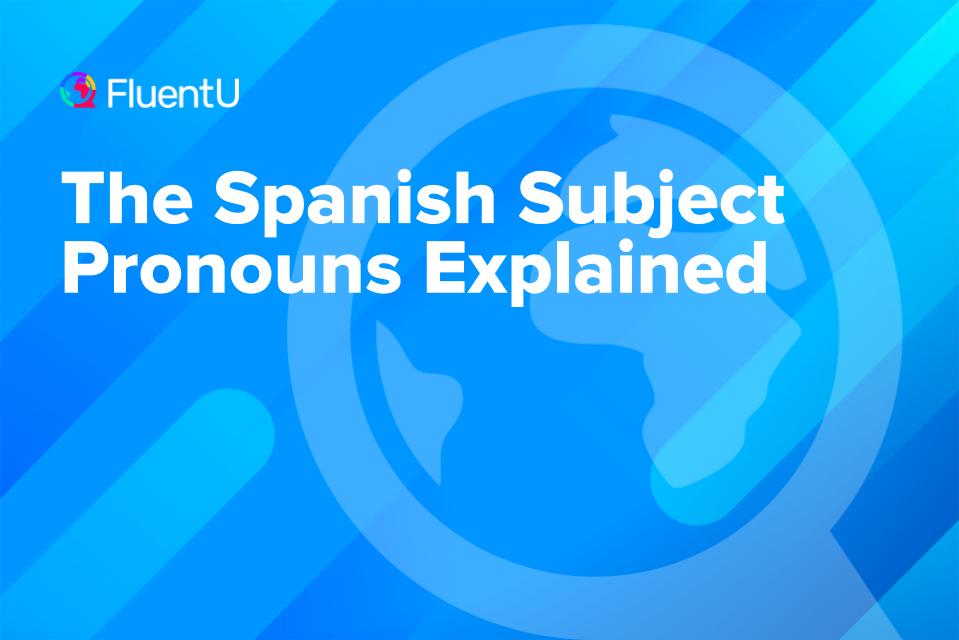The Spanish Subject Pronouns Explained

You’ve probably seen words like yo, tú, él or ella in your beginner’s Spanish book. They’re called subject pronouns, and they indicate who or what is performing an action. Subject pronouns are vital for forming clear, accurate sentences, so understanding them is a fundamental step toward mastering the language.
In Spanish, pronouns can shift depending on the formality, gender, or number of the subjects involved, making them slightly more nuanced than in English. I’ll walk you through the essentials of Spanish subject pronouns, providing examples and highlighting regional variations to help you use them with confidence.
Download: This blog post is available as a convenient and portable PDF that you can take anywhere. Click here to get a copy. (Download)
What Are Spanish Subject Pronouns?
Spanish subject pronouns are words used to refer to the subject of a sentence, and their role is to indicate who or what is performing an action. They change depending on who you’re talking to or about, and whether it’s a singular or plural. It’s important to know these little words as you will see them used frequently in the Spanish language!
Here is a quick overview of Spanish subject pronouns:
| Spanish Subject Pronoun | English |
|---|---|
| Yo | I |
| Tú | You |
| Él/Ella | He / She |
| Usted | You (formal singular) |
| Nosotros/Nosotras | We (masculine/feminine) |
| Vosotros/Vosotras | You all (masculine/feminine, informal plural) |
| Ellos/Ellas | They (masculine/feminine) |
| Ustedes | You all (formal plural) |
For more detail about each of these pronouns and how they’re used, keep on reading!
Spanish Subject Pronouns
1. Yo — I
The first person pronoun is yo (I) and always refers to the person who is speaking:
Yo tengo 27 años.
(I am 27 years old.)
Yo no soy polaco.
(I am not Polish.)
Yo estoy escuchando música.
(I am listening to music.)
2. Tú — You (informal)
This is the Spanish “you,” or the informal second person singular. We use it only in casual situations, typically where we know the other person well.
You probably won’t use tú when talking to an older person, boss or an unknown person on the street (unless they were a little child).
You would use tú when talking to friends, families, coworkers of similar standing, etc. Visit this post for more information on when to use tú vs. usted (formal “you”).
Here are some examples:
Tú eres muy inteligente.
(You are very intelligent.)
¿Quieres tú un café?
(Do you want a coffee?)
Tú no puedes venir porque tú no has hecho los deberes.
(You can’t come because you haven’t done your homework.)
3. Él (m.) / Ella (f.) — He/She
Él and ella are the Spanish third-person singular personal pronouns, and they are translated as “he” and “she,” respectively.
In Spanish, every noun is either feminine or masculine, so it doesn’t matter if our third person is a person, an animal, a thing or a thought. They will just be either “he” or “she” in Spanish, whereas they could translate as “it” in English.
Let’s have a look at some examples:
Mi hermana es estudiante. Ella estudia biología.
(My sister is a student. She studies biology.)
El profesor llegó 5 minutos tarde. Él había perdido el autobús.
(The professor arrived 5 minutes late. He had missed the bus.)
El perro se llama Pepe. Él es muy divertido.
(The dog is called Pepe. He is very funny.)
Mi gata está en la cocina. Ella tiene hambre.
(My [female] cat is in the kitchen. She is hungry.)
(Yo) Me he encontrado un libro. Él es muy antiguo.
(I have found a book. It is very old.)
4. Usted — You (formal)
Usted is the pronoun we use when talking directly to someone in a formal context, such as to a boss, a teacher or someone you consider higher than you in a social hierarchy.
Its conjugations are the same as él and ella. The good news is that usted does not differentiate gender, so the pronoun will always be the same:
¿Quiere usted algo?
(Would you like something?)
Deme usted la mano, por favor.
(Give me your hand, please.)
Usted debe volver mañana.
(You have to come back tomorrow.)
5. Nosotros (m.) / Nosotras (f.) — We
Nosotros and nosotras are translated as “we,” but as you can see, the form changes depending on the gender of the people in the group.
You will only use nosotras if you are talking about a group of only women. If it is a group of all men or a group of mixed genders, you will use nosotros:
Nosotros vamos a ganar.
(We are going to win.)
Mi novia y yo nos queremos. Nosotros somos muy felices.
(My girlfriend and I love each other. We are very happy.)
Ana y yo hemos aprobado. Nosotras Habíamos estudiado mucho.
(Ana and I have passed. We had studied a lot.)
6. Vosotros (m.) / Vosotras (f.) — You (informal, plural)
Here we have yet another pair of pronouns that are translated into English as “you.”
In this case, we have the informal “you” pronouns, which are used when you are talking directly to two or more people you know well.
As you can see, this also has two different forms in Spanish, one masculine and one feminine. The rules are the same for which form to use as nosotros:
Vosotros habláis muy alto.
(You [guys/all] speak very loudly.)
(Antonio + Susana) Vosotros sois españoles.
(You [two/both] are Spanish.)
Vosotras sois muy guapas.
(You [girls/all] are very pretty.)
7. Ellos (m.) / Ellas (f.) — They (plural)
Ellos and ellas are the third person plural personal pronouns, which translates to “they.”
Once again, ellos is used for all male and mixed gender groups, while ellas is for groups that only have females:
(Juan + Antonio) Ellos tienen hambre.
(They are hungry.)
(Pedro + Isabel) Ellos están casados.
(They are married.)
(Ana + Lucía) Ellas son de Murcia.
(They are from Murcia.)
8. Ustedes — You (formal, plural)
Just as there is a plural version of él and ella, there is a plural version of usted, which follows the same conjugations for ellos and ellas.
When we have a formal situation and we are talking directly to a group of people, we have to use ustedes.
Like with the form usted, the plural ustedes is not gender specific. So the pronoun will remain the same, no matter what the genders of the group are:
¿Tienen ustedes alguna pregunta?
(Do you have any questions?)
Ustedes tienen razón.
(You are right.)
¿De dónde son ustedes?
(Where are you from?)
When to Use Spanish Personal Pronouns
When talking or writing in Spanish, you almost never need to use personal pronouns unless you want to emphasize or specify.
Spanish speakers will understand who you are talking about based on the conjugation of the verb.
For example, rather than saying, “Yo tengo 27 años,” you would say:
Tengo 27 años.
(I am 27 years old.)
Regional Differences in Spanish Personal Pronouns
As you probably know, there are as many varieties of Spanish as there are Spanish-speaking countries.
Normally, different regions have similar grammar, vocabulary and usage, but there are times when you can clearly see the differences, especially between Castilian Spanish and Latin American Spanish.
One of these main regional differences can be found in personal pronouns, or more specifically, vos and vosotros.
Vos
Vos has the same meaning as tú, but it is only really used in Argentina, Paraguay, Uruguay, Chile, Nicaragua, Guatemala, El Salvador, Honduras and Costa Rica.
You will never hear vos in Spain, but people will know what it means no matter where you go. Here you can see that it is interchangeable with tú and other second-person pronouns:
¿Tú cómo te llamas?
¿Vos cómo te llamas?
(What is your name?)
Now, in some countries vos follows the exact same conjugation rules as tú:
Tú eres muy inteligente.
Vos eres muy inteligente.
(You are very intelligent.)
However, in countries like Argentina and Uruguay, you’ll notice some important changes to these rules—especially in the present tense:
Tú eres buen amigo.
Vos sos buen amigo.
(You are a good friend.)
Tú tienes una voz hermosa.
Vos tenés una voz hermosa.
(You have a beautiful voice.)
You can learn more about the use of vos (or voseo) here.
Vosotros
Although we already touched on vosotros, it is good to know that this personal pronoun is only used in Spain.
Latin American Spanish uses ustedes for both informal and formal situations, so there’s no need to use vosotros at all. If you ever hear someone outside of Spain use vosotros and they’re not a Spaniard, they’re probably just trying to impersonate one!
Differences Between English and Spanish Subject Pronouns
In many ways, Spanish and English personal pronouns are quite similar, but there are some crucial differences:
- Spanish personal pronouns aren’t always necessary. As we mentioned earlier, a lot of times Spanish speakers will leave a pronoun entirely out of a sentence.
- You can use personal pronouns to show emphasis. Although they are not necessary, you can selectively include pronouns for emphasis, like when you want to express surprise, excitement or even aggression.
- ¿Qué haces tú aquí? (What are you doing here?)
- Word order isn’t as rigid as in English. A pronoun can often go before or after the verb with no problem. If you look at “We are going to the party” in Spanish, you could write:
- Nosotras vamos a la fiesta. / Vamos nosotras a la fiesta. / Vamos a la fiesta.
- When asking questions, put the personal pronoun after the verb. For example:
- ¿Trabajas tú en la biblioteca? (Do you work in the library?)
- In Spanish, there is more than one way to say “it.” You can use lo and la, but él and ella can also work as indirect object pronouns to mean “it.”
- ¿Dónde está tu chaqueta? No puedes salir sin ella! (Where is your jacket? You can’t leave without it!)
- The accent marks are crucial. Tú and él have accent marks, and leaving them out can completely change the word’s meaning.
Resources for Understanding Spanish Pronouns
Already feeling great about this lesson and hooked on pronouns? Check out our other Spanish pronoun guides for even more valuable information:
- An Overview of Spanish Pronouns
- Spanish Possessive Pronouns
- Spanish Indefinite Pronouns
- Spanish Interrogative Pronouns
- Spanish Demonstrative Pronouns
- Spanish Relative Pronouns
You can also immerse yourself in Spanish movies, music and books or check out a language learning program to help you learn and practice Spanish pronouns.
FluentU is one option for this, as the program comes with a video library containing clips from movies, vlogs, music videos and more, which all feature native speakers.
FluentU takes authentic videos—like music videos, movie trailers, news and inspiring talks—and turns them into personalized language learning lessons.
You can try FluentU for free for 2 weeks. Check out the website or download the iOS app or Android app.
P.S. If you decide to sign up now, you can take advantage of our current sale!

You can also check out this video from the FluentU Spanish YouTube channel to learn about Spanish subject pronouns with a story.
Now you should feel more confident when using Spanish subject pronouns. The more you practice, the better you’ll get!
Happy learning!
Download: This blog post is available as a convenient and portable PDF that you can take anywhere. Click here to get a copy. (Download)
And One More Thing…
If you've made it this far that means you probably enjoy learning Spanish with engaging material and will then love FluentU.
Other sites use scripted content. FluentU uses a natural approach that helps you ease into the Spanish language and culture over time. You’ll learn Spanish as it’s actually spoken by real people.
FluentU has a wide variety of videos, as you can see here:

FluentU brings native videos within reach with interactive transcripts. You can tap on any word to look it up instantly. Every definition has examples that have been written to help you understand how the word is used. If you see an interesting word you don’t know, you can add it to a vocab list.

Review a complete interactive transcript under the Dialogue tab, and find words and phrases listed under Vocab.

Learn all the vocabulary in any video with FluentU’s robust learning engine. Swipe left or right to see more examples of the word you’re on.

The best part is that FluentU keeps track of the vocabulary that you’re learning, and gives you extra practice with difficult words. It'll even remind you when it’s time to review what you’ve learned. Every learner has a truly personalized experience, even if they’re learning with the same video.
Start using the FluentU website on your computer or tablet or, better yet, download the FluentU app from the iTunes or Google Play store. Click here to take advantage of our current sale! (Expires at the end of this month.)







